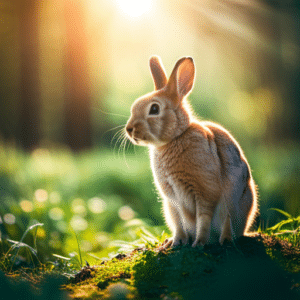Have you ever wondered “why your rabbit is running in circles and how to help” them? Understanding the reasons behind this behavior can help you better care for your pet and ensure their happiness. In this blog post, we will explore various causes for circling behavior and provide practical solutions to help your furry friend thrive.
Key Takeaways
Neutering/spaying rabbits can help reduce hormone-driven behaviors such as circling.
Providing mental stimulation and exercise is essential to prevent boredom in rabbits, which can lead to excessive circling behavior.
Building trust and bonding with your rabbit requires gentle handling, quality time, positive reinforcement, and supporting their hind legs during interactions.
Understanding Rabbit Circling: Common Causes

Rabbits possess a complex range of behaviors that can sometimes puzzle their owners. Circling is one such behavior that can be attributed to multiple factors, such as courtship, playfulness, or seeking attention. Understanding these potential causes of circling enables you to meet their needs and promote a happier, healthier pet.
Courtship Behavior
Circling can serve as a form of courtship behavior in rabbits, signifying their readiness to mate or establish dominance. When rabbits circle each other, it often represents a display of hierarchy, with one rabbit asserting dominance over the other. Female rabbits may use circling as a courtship ritual to show potential mates they are interested. This is known as a mating dance.
As fascinating as these rabbits display courtship, the displays may be problematic, especially if you do not intend to breed your rabbits. If you don’t plan to breed your rabbits, consider neutering or spaying them to curb this courtship-related circling.
Playful Behavior
Sometimes, circling behavior can simply be an expression of joy and excitement. Rabbits might engage in running in circles when they are happy, enthusiastic, or have excess energy. This exuberant display, often referred to as “zoomies,” typically occurs in short bursts and can be reduced if the rabbit is neutered or spayed.
Offer your rabbit engaging toys and plenty of exercise opportunities to promote healthy play and discourage excessive circling. This can help channel their energy into positive, stimulating activities and reduce the frequency of zoomies.
Seeking Attention
Rabbits might also circle their owners as a way of seeking attention, play, or interaction. This behavior can be observed when a rabbit is excited to see their owner, anticipates a treat, or simply desires some affection. While it is generally a positive indication of your rabbit’s mood, excessive circling may signal that your pet requires more mental stimulation or attention.
If your rabbit circles to seek attention, here are some ways to alleviate this behavior:
Spend quality time with them daily
Engage in play sessions
Groom your rabbit regularly
Participate in bonding activities to help your rabbit feel secure, loved, and entertained.
The Role of Reproductive Hormones

Reproductive hormones, such as estrogen in female rabbits and testosterone in male rabbits, can play a significant role in influencing circling behavior. Knowing the role of these hormones in your rabbit’s behavior allows for more effective management and resolution of underlying issues.
Male Rabbits
In male rabbits, circling behavior may be driven by their desire to court potential mates or assert dominance over others. This rabbit behavior typically occurs after male rabbits reach sexual maturity and can be accompanied by other courtship behaviors, such as chasing, dancing, and spraying urine.
For male rabbits, neutering can have several benefits:
Lessening hormone-driven behaviors, resulting in less aggression and territoriality
Leading to a more relaxed and well-behaved pet
Preventing unwanted litters
Female Rabbits
Female rabbits may display the following behaviors during mating season, often in response to the presence of a male rabbit:
Circling behavior, driven by hormonal changes and the desire to attract potential mates or signal interest
Presenting themselves for mounting
Marking their territory
For female rabbits, spaying can control hormone-driven circling and lessen aggression and territorial behaviors. This not only benefits your rabbit’s overall well-being but also helps prevent unwanted litter and associated complications.
How Neutering/Spaying Can Help

Neutering or spaying your rabbit is a significant measure in managing circling behavior. By eliminating the influence of reproductive hormones, neutering or spaying can help prevent unwanted litters and reduce hormone-driven behaviors, including circling.
The subsequent sections will provide a detailed examination of the benefits of neutering or spaying your rabbit.
Preventing Unwanted Litters
Neutering or spaying your rabbit is an effective method for preventing unwanted litters, which can contribute to courtship-related circling behavior. By getting your rabbit fixed, you can ensure a more stable and peaceful home environment, free from the challenges of managing multiple rabbits.
Moreover, neutering or spaying can help reduce the risk of medical complications associated with reproduction, such as uterine cancer in female rabbits or testicular cancer in male rabbits. This further highlights the importance of neutering or spaying for the well-being of your pet rabbit, especially when considering neutered rabbits.
Reducing Hormone-Driven Behaviors
Neutering or spaying is key in curbing hormone-driven circling behavior in rabbits. By regulating hormone levels, neutering or spaying can help lessen territorial and aggressive behaviors in both male and female rabbits.
Although neutering or spaying may not eliminate all hormone-driven behaviors, it can significantly reduce their frequency and intensity, leading to a more content and manageable pet. This makes neutering or spaying an essential consideration for responsible pet owners looking to improve their rabbit’s overall well-being and quality of life.
Providing Mental Stimulation and Exercise

Boredom and lack of mental stimulation can also contribute to circling behavior in rabbits. Offer your rabbit engaging activities, exercise, and mental stimulation to avert boredom and decrease circling.
The upcoming sections will outline various strategies to entertain your rabbit and stimulate their mind.
Interactive Toys
Interactive toys are great for engaging your rabbit and avoiding excessive circling during playtime. Toys designed specifically for rabbits, such as chew toys, tunnels, and foraging toys, can provide mental and physical stimulation, encouraging them to focus their energy on the activity rather than circling.
When selecting interactive toys for your rabbit, consider factors such as safety, durability, and variety. Offering a range of toys can help keep your rabbit engaged and entertained, reducing the chances of boredom and excessive circling.
Enrichment Activities
Enrichment activities, such as tunnels and chewing materials, can help minimize problematic circling behavior in rabbits. By providing a stimulating environment that promotes natural behaviors like digging and foraging, you can help reduce boredom and keep your rabbit entertained.
In addition to store-bought toys, you can create DIY enrichment activities for your rabbit using household items. For example, food forage trays, cardboard boxes, and willow or hay balls can offer hours of entertainment and mental stimulation for your pet.
Regular Exercise
Regular exercise is vital for maintaining your rabbit’s overall health and well-being. Providing opportunities for physical activity can help your rabbit release pent-up energy, reducing the likelihood of circling behavior. Exercise can also alleviate stress and anxiety, which may contribute to excessive circling.
To ensure your rabbit gets the exercise they need, aim to provide them with up to 4 hours of supervised exercise outside of their cage daily. This can include:
running
jumping
climbing
foraging activities
These activities, designed for prey animals like rabbits, can be achieved by providing ramps, boxes, tunnels, and rabbit runs for your rabbit to explore.
Dealing with Rabbit Anxiety

Rabbit anxiety can manifest in various ways, including circling behavior. Addressing anxiety causes and creating a comfortable, secure environment for your rabbit can alleviate stress-related circling.
The subsequent sections will detail how to identify stressors, create a safe environment, and introduce gradual changes to lessen anxiety and circling.
Identifying Stressors
Identifying stressors in your rabbit’s environment is the first step in creating a comfortable and secure space for them. Common sources of stress for rabbits include:
Changes in routine
Unfamiliar sounds
Inadequate housing conditions
Social isolation
By recognizing and addressing these stressors, you can minimize anxiety and create a more comfortable environment for your rabbit. This, in turn, can lead to a reduction in circling behavior and other stress-related issues.
Creating a Safe Space
A safe and comfortable environment is essential for your rabbit’s well-being. Providing a secure living space, appropriate bedding, and protection from extreme temperatures can help your rabbit feel more at ease, reducing anxiety-related circling behavior.
In addition to physical comforts, establishing a consistent routine and offering social interaction can also contribute to a sense of security for your rabbit. By addressing your rabbit’s needs and creating a safe space, you can help minimize anxiety and circling behavior.
Gradual Changes

Introducing changes gradually and maintaining a consistent routine can help minimize anxiety and circling behavior in rabbits. Sudden alterations in routine or environment can provoke feelings of anxiety, leading to stress-induced circling.
When making changes to your rabbit’s environment or routine, do so slowly and with care. This allows your rabbit to adjust and feel more secure, reducing the likelihood of anxiety-related circling behavior.
Building Trust and Bonding with Your Rabbit
Establishing trust and forming a bond with your rabbit can greatly improve their overall well-being and help mitigate circling behavior.
The upcoming sections will cover how gentle handling, quality time, and positive reinforcement can strengthen the bond between you and your rabbit, while also discussing the importance of supporting their hind legs during interactions.
Gentle Handling
Gentle handling is essential for creating trust between you and your rabbit. Rabbits are sensitive creatures, and sudden movements or rough handling can cause them to feel threatened and fearful. By approaching your rabbit calmly and handling them with care, you can help establish trust and reduce anxiety-related circling behavior.
In addition to gentle handling, it is crucial to be patient with your rabbit as they adjust to your presence. Allow your rabbit to approach you on their terms and reward their curiosity with treats or gentle petting. Over time, this can help foster a strong bond and trust between you and your rabbit.
Spending Quality Time

Spending quality time with your rabbit is essential to building trust and a strong bond. This can include playtime, grooming sessions, or simply sitting with your rabbit as they explore their environment. By dedicating time to your rabbit and providing them with the attention they crave, you can help improve their overall well-being and reduce circling behavior.
Remember to be patient and consistent in your interactions with your rabbit. Building trust takes time, but by providing regular companionship and positive reinforcement, you can create a lasting bond with your pet.
Positive Reinforcement
Using positive reinforcement to reward calm behavior can help modify your rabbit’s circling behavior. By rewarding your rabbit when they exhibit desirable behaviors, such as calmly approaching you or exploring their environment, you can create a positive association and reinforce their trust in you.
Regular use of positive reinforcement can build a strong bond and trust between you and your rabbit over time. This not only improves their overall well-being but also contributes to a reduction in circling behavior and other problematic issues.
Summary
Understanding the reasons behind your rabbit’s circling behavior is the first step in addressing any underlying issues and ensuring their happiness. By considering factors such as courtship, playfulness, anxiety, and hormones, you can take appropriate action to help your rabbit thrive. Neutering or spaying, providing mental stimulation and exercise, addressing anxiety, and building trust are all effective strategies to reduce circling behavior and improve your rabbit’s overall well-being. With patience, understanding, and dedication, you can foster a strong bond with your rabbit and create a happy, healthy environment for your furry friend.
Frequently Asked Questions
Why is my rabbit running in circles?
Your rabbit running in circles is an indication of their affection for you. This is a common behavior seen in rabbits and is often accompanied by a quiet oinking or buzzing sound.
Can neutering or spaying my rabbit help reduce circling behavior?
Neutering or spaying your rabbit can help reduce circling behavior as it prevents unwanted litters and reduces hormone-driven behaviors.
How can I provide mental stimulation and exercise for my rabbit to help reduce circling behavior?
Providing interactive toys, enrichment activities, and regular exercise can help keep your rabbit mentally stimulated and reduce circling behavior.
What can I do to build trust and bond with my rabbit?
Gentle handling, spending quality time with your rabbit, and rewarding calm behavior can help build trust and a bond with your rabbit, improving their overall well-being.



